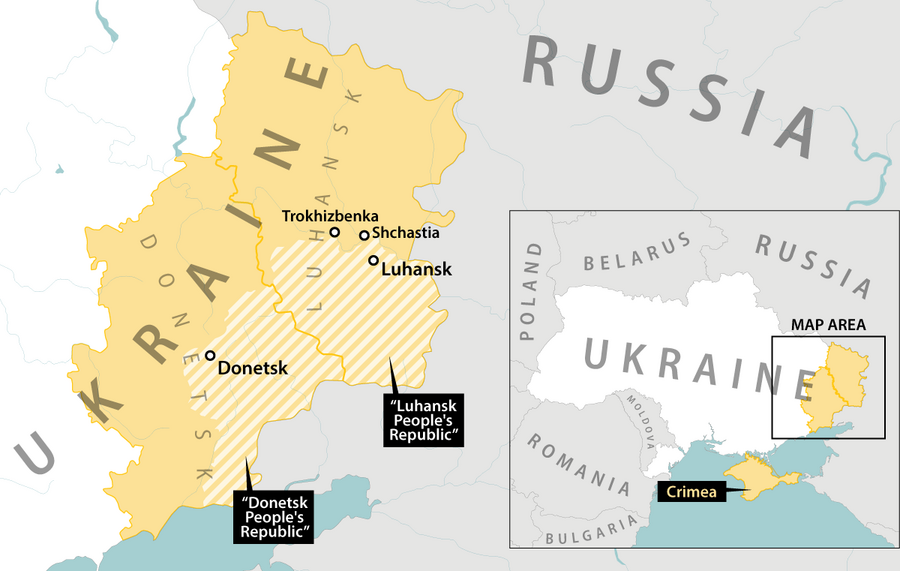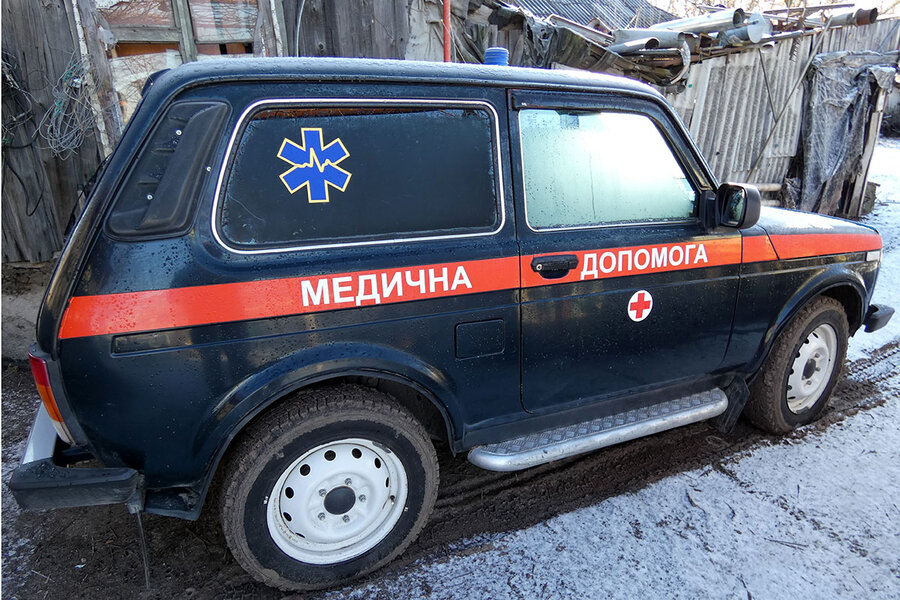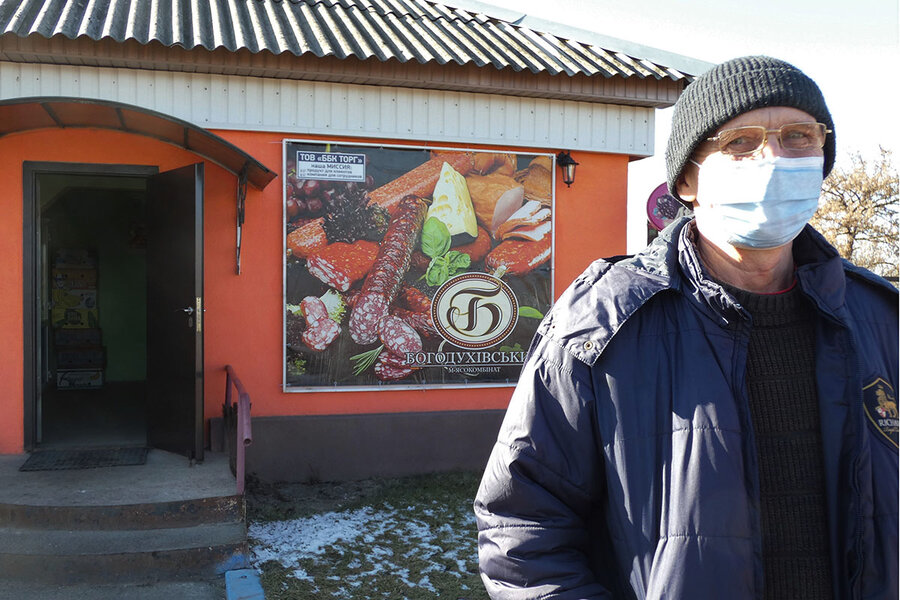As Ukraine-Russia conflict looms, Donbass residents watch and wait
Loading...
| Trokhizbenka, Ukraine
Ukrainians in the country’s eastern regions already inhabit a perilous limbo, due to the frozen conflict between the breakaway regions of Donetsk and Luhansk and the government in Kyiv.
But Russian President Vladimir Putin’s order for more Russian troops to deploy to the regions portends a life further constricted, disrupted, deprived. Shorn of a sense of possibility after eight years of war, they endure their plight with subdued fatalism.
Why We Wrote This
Portraits of resilience: The fight over parts of Ukraine has left families divided, literally living and working on either side of the front lines.
The eight-year war in the southeast has killed 14,000 people and displaced 1.5 million residents, splitting families and gutting local economies. Those living in Luhansk and Donetsk, an agricultural and industrial region known as Donbass, wonder why Ukrainian and Western leaders have waited until this fraught moment to respond to their plight with greater urgency.
“We have been forgotten,” says Liliya Shvets, the lone nurse in the clinic of a farming village near the separatist-held city of Luhansk. She and her husband drive patients to the nearest hospital 90 minutes away in the clinic’s ambulance – their own two-door car, topped with a blue siren. “People are remembering us now, but what can they do to help? It is too late.”
“The last house in Ukraine” stands along a swampy dirt road 30 yards from a military checkpoint fortified with machine gun nests draped in camouflage netting. Less than a quarter-mile south lies a river dividing government-controlled land from territory that pro-Russian separatists occupy in this rural enclave of the Luhansk region.
The house belongs to Vladimir and Liliya Shvets, whose sardonic description of their home traces to 2014, when war ruptured southeastern Ukraine. The large swaths of Luhansk and the neighboring Donetsk region seized by Russian-backed forces that spring included Trokhizbenka, a farming village clustered beneath the gleaming golden domes of a Russian Orthodox church.
Ukrainian troops drove out enemy fighters from the town four months later. But the decision Monday by Russian President Vladimir Putin to assert the independence of the breakaway territories casts the fragile status quo of residents along the 250-mile front line into deeper uncertainty.
Why We Wrote This
Portraits of resilience: The fight over parts of Ukraine has left families divided, literally living and working on either side of the front lines.
“It’s almost like we don’t exist,” says Mr. Shvets, a retired truck driver. “A nowhere place.”
For Ukrainians in the east, who already inhabit a perilous limbo, Mr. Putin’s order for more Russian troops to deploy to Luhansk and Donetsk portends a life further constricted, disrupted, deprived. Shorn of a sense of possibility after eight years of war, they endure their circumstance with subdued fatalism.
The checkpoint outside Mr. and Mrs. Shvets’ home marks Trokhizbenka as a border town some 75 miles from Ukraine’s true southern boundary with Russia. The closed road leads to the city of Luhansk, where they once sold their homegrown produce at a popular street market. Since 2014, the city has served as the capital of the self-declared Luhansk People’s Republic.
“We are people caught somewhere between Ukraine and Russia,” says Mr. Shvets. “Sometimes I ask, ‘Why must it be this way?’”
An inflamed “frozen conflict”
The collective alienation of residents mired in the country’s frontline purgatory has sharpened as Western leaders warn of Russia launching a full-scale invasion following Monday’s events.
Mr. Putin’s formal recognition of the Luhansk People’s Republic and its Donetsk counterpart drew a swift rebuke from the United States and several other countries at a meeting of the United Nations Security Council. U.S. and European Union officials announced an initial round of economic sanctions against Russia and threatened subsequent penalties if Mr. Putin fails to reverse course. German Chancellor Olaf Scholz said he would suspend the approval process for Russia’s Nord Stream 2 gas pipeline.
The Russian military has positioned up to 190,000 troops on Ukraine’s border in recent months, and shelling of Ukrainian army and civilian targets in Luhansk and Donetsk has intensified in the past week. Defense officials in Kyiv have reported hundreds of rocket attacks across the front line, with two soldiers and a civilian killed.
Political observers suggest that Mr. Putin’s recognition of separatists’ claims to the two-thirds of Donbass under Ukrainian control could inflame the country’s “frozen conflict” beyond its existing dimensions.
Following Russia’s annexation of Crimea in 2014, his latest gambit reaffirms his disregard for Ukraine’s territorial integrity, says Olexiy Haran, a professor of comparative politics at the National University of Kyiv-Mohyla Academy. He contends that deterring Russia will require Ukrainian President Volodymyr Zelenskyy to redouble his appeals for international support and possibly signal a willingness to consider military force.
“I expect a Russian escalation in all of Donbass – not just the parts under occupation – and potentially beyond that,” Mr. Haran says. “So Ukraine may have to show now instead of later that there are options in addition to diplomacy and sanctions.”
“We have been forgotten”
The war in the southeast has killed 14,000 people and displaced 1.5 million residents, splitting families and gutting local economies. Those living in Luhansk and Donetsk, an agricultural and industrial region known as Donbass, wonder why Ukrainian and Western leaders have waited until this fraught moment to respond to their plight with greater urgency.
“Where have all the politicians been?” Mrs. Shvets says. She recalls that for most of the war’s first year, as separatists continued shelling Trokhizbenka after Ukrainian troops liberated the town, she and her husband lived in the brick cellar behind their home.
In a space about the size of two portable toilets, they huddled beside a wood stove for warmth and offered prayers to a palm-sized icon of Jesus. If the day brought a reprieve from chaos, they climbed the cellar’s ladder and picked fruits and vegetables from their backyard plot or slipped inside the house to bathe, then returned to their underground shelter.
“We have been forgotten,” says Mrs. Shvets, the lone nurse in the village’s dim, drafty health clinic, which has lacked a full-time doctor since the war began. The couple drives patients to the nearest hospital 90 minutes away in the clinic’s ambulance – their own two-door Lada topped with a blue siren. “People are remembering us now, but what can they do to help? It is too late.”
The dark prospect of bloodshed has hovered over daily life in Luhansk and Donetsk since separatist forces arrived. Anatoliy and Halyna Korzhensky abandoned their home in the city of Luhansk when war broke out in 2014. They resettled in Trokhizbenka and run a small grocery, sleeping in an adjacent room a few inches wider than their double bed.
The upheaval in Luhansk cleaved their family. Mr. Korzhensky’s father and several of the couple’s relatives still live in the city, and the complicated process of crossing to and from the occupied side has limited father and son to one or two visits a year. Mr. Korzhensky spoke with him earlier this week and heard distress in his voice.
“He can’t sleep – he’s too worried about what Putin may do,” Mr. Korzhensky says. He and his wife channel their own unease into work. They greet customers and restock shelves as they seek distraction from thoughts of needing to flee again.
Nodding with each word for emphasis, Mrs. Korzhensky says, “We will survive.” She stands in her kitchen, a converted storage closet, with a pot of goat stew simmering on a hot plate. Her stove, like most everything else the couple owned in Luhansk, was lost to the war. “We don’t know how, but we have survived and we will survive.”
“This is all political”
Anastasia Kozachek pulls down her T-shirt's neckline to reveal a large red scar on her left collarbone. The summer day in 2014 when she endured the injury marked the start of her war in Donbass.
Russian-backed forces had taken control of the southern portions of Luhansk and Donetsk a few months earlier. But the conflict remained abstract to Ms. Kozachek, a Kyiv native, until she made the long drive to visit relatives in Schastya, an industrial town in the shadow of the front line.
As she reached the city’s outskirts, a mortar shell exploded beside the road, sending her car spinning. A jagged piece of shrapnel pierced her collarbone. “In that second, everything changed,” she says, sitting in her kitchen in Shchastia, the scent of baked whitefish lingering from dinner. “I would fight for Ukraine.”
Ms. Kozachek enlisted in the military after recovering and served four years in its medical corps in the combat zone. She settled in Shchastia after her discharge to raise Kyrylo, her preschool son, with the help of family. Yet in recent months, with the sounds of war swelling, she had begun mulling a return to Kyiv. Mr. Putin’s actions this week tipped her thinking.
“I’m moving back,” she says. Separatists shelled part of the town’s massive power plant Tuesday, and from her kitchen window she could see thick clouds of black smoke. “I’m a mother, and I have to do what is right for my child.”
The language, religious rituals, and cultural traditions of Russia prevail in Donbass, and the region’s people regard the governments of Kyiv and Moscow with equal skepticism. At the same time, when discussing the war and the threat to Ukraine’s independence, they voice little doubt about the culprit.
“I don’t have a lot of trust in the Verkhovna Rada,” says Larisa Bonderchuk, referring to Ukraine’s parliament. “But what’s happening is happening because of Putin.”
A Schastya native and Ms. Kozachek’s aunt, she lost her financial services job in Luhansk after separatists occupied the city. She now earns less than half her former salary as the manager of a street market. “I don’t blame the Russian people for what Ukraine is going through,” she says. “Like Ukrainians, I don’t think most of them want war. This is all political.”
An expectation of war
Trokhizbenka’s prewar population of 3,000 has dropped by about half. The echo of artillery fire, at once familiar and unwelcome to the residents who remain, has returned to the village, where a statue of Kondraty Bulavin stands outside the Russian Orthodox church. The Ukrainian Cossack led a revolt against Peter the Great in the early 18th century in reaction to the Russian czar infringing on Cossack autonomy and territory.
Mr. and Mrs. Shvets, who speak at length of their allegiance to Ukraine and disdain for Mr. Putin, admit to sporadic nostalgia for the Soviet Union. Mr. Shvets, the retired trucker, remembers logging 60,000 miles a year behind the wheel, crossing from one Soviet republic to another without needing to ease off the accelerator. Now the road beside their house ends almost at their property line at a Ukrainian military checkpoint.
As they take turns petting Kuzya, a mellow calico cat, Mr. and Mrs. Shvets sit in their kitchen below a ceiling several shades whiter than elsewhere in the one-bedroom home. The couple repaired and repainted this section after rocket shrapnel shredded part of the rooftop in 2017.
They expect more war to come. They will stay.
“We are old, we have little money,” Mrs. Shvets says. “Where else do we go?”












